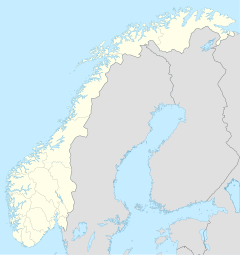Damsgård hovedgård
| Damsgård Manor | |
|---|---|
 |
|
| General information | |
| Type | Manor |
| Architectural style | Rococo |
| Location | Laksevåg, Bergen, Norway |
| Completed | Around 1770 |
Damsgård Manor (Norwegian: Damsgård hovedgård) is a landmark manor and estate in Bergen, Norway. It is noted for its distinct rococo style and is possibly the best preserved wooden building from 18th-century Europe.
The area surrounding the manor was most likely populated during the Viking era or earlier, but literary evidence shows it was a population center in 1427, listed as church property. Following the Reformation in 1536, the estate was taken over by the crown and then sold to foreign interests.
The name is most likely derived from Dam Tønneson, who in 1654 inherited the farm from his father Tønnes Klausson, who in turn received it from Frederick II of Denmark due to his service during the Northern Seven Years' War. The oldest sections of the structure, however, are probably from around 1720, when (1664-1726) owned the estate. At the time, the buildings were painted bright red and green. An estimate for the main house from 1731 exists and indicates the general layout of the structure. By all accounts, the estate was a year-round farm and a recreational property.
(1730-1795), later knighted Gyldenkrantz, took over the farm in 1769 and quickly began the Rococo construction that exists to this day. He also rebuilt the main house to face the maritime approach to Bergen. Shortly after Gyldenkrantz died, the property was sold to Herman Didrich Janson, one of the wealthiest men of his time. He only completed minor external changes but thoroughly renovated the interior of the houses. The Janson family maintained ownership of the estate until 1983, when it was taken over by , which embarked on a 10-year restoration effort, in collaboration with the Directorate for Cultural Heritage in Norway. It was put on the protected list, and Bergen Museum took over the estate.
Damsgård is one of the few buildings of the rococo architectural style in Norway, and is unusual as a rococo wooden structure in Europe. The facade of the main building exaggerates the dimensions of the house itself, and two windows are painted on to create symmetry. The building's interior layout has been restored to its original, early 18th century plan, and the interior to the different eras of Damsgård's history.
...
Wikipedia

